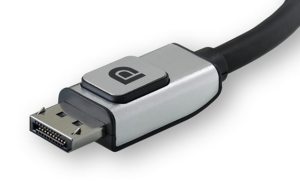VESA has published DisplayPort v1.4 – the first major update since v1.3, which was approved in September 2014. It is the first version of DisplayPort to use VESA’s Display Stream Compression (DSC) technology. It will also support Forward Error Correction (FEC); this overlays the DSC 1.2 transport, and is intended to raise transport error resiliency, which is required for compressed video transport to external displays.
FEC is a technique to control errors in data transmission over unreliable or noisy channels. At its base, the sender encodes a message using an error-correcting code; the receiver can then detect errors and correct them without needing to request retransmission of the data.
DSC, which we have been covering since early 2013 (Display Monitor Vol 20 No 05), is a system to reduce data bitrates to enable more data to be transferred over existing interfaces. DSC v1.2 enables up to a 3:1 compression ratio, and has been deemed to be visually lossless.
The use of video transport compression in DisplayPort 1.4 enhances the standard’s ability to take advantage of the USB-C connector (DisplayPort Alt Mode). HDR and 8K video will be able to be transported across DisplayPort or USB-C connections. 8k at 60Hz, or UltraHD at 120Hz, with HDR and deep colour, will be supported. Improvements have been made in the multi-stream transport (MST) over USB-C.
The standard will support CTA 861.3, through the ‘secondary data packet’ built in to DisplayPort. CTA 861.3 is useful for converting DisplayPort to HDMI 2.0a; it also offers a metadata packet transport, to support future dynamic HDR standards.
Version 1.4 also improves support for audio including capabilities such as 32 audio channels, 1536kHz sample rate, and inclusion of ‘all known’ audio formats.
Analyst Comment
Unlike previous versions of DisplayPort, there is no boost to the speed of the physical layer of the standard. However, the overall throughput will improve because of DSC. We spoke to VESA and we heard that, like any interface, DisplayPort has errors in some data. The error rate has been estimated (and we believe that this estimate took a lot of work to arrive at!) at around 10-9 bits in the ‘worst case’. This would not normally be visible. As the number of pixels goes up, the number of errors does as well, so high resolutions get harder. Further, the use of DSC compression means that such errors can cause more ‘blocky’ errors that can become visible and that would not be acceptable, so a lot of work was done to support FEC. With FEC, errors are in the realm of 10-18 or 10-20.
DSC has previously been used in ‘closed’ systems such as eDP in notebooks and in these cases, which do not have to support long cables or multiple connectors, the error rate is smaller, so was not an issue.
As we report in our MWC coverage this week, in Mobile Display Monitor, the support of 861.3 static metadata helps with carrying HDMI over DisplayPort. There is a view that it will be cheaper to support HDMI over Type-C by using DP and converting to HDMI than it would be to develop a native ‘Alt’ mode for delivery of HDMI over USB Type-C.
At the ERC event in Vienna, I was talking to someone who pointed out that they cannot currrently find graphics boards with DP 1.3. I would guess that adding the extra algorithms for DP1.4 may not slow down chip development too much. If so, perhaps some vendors are looking to skip over DP 1.3 and go directly to 1.4? If you have a view on this, do contact me! (BR)

